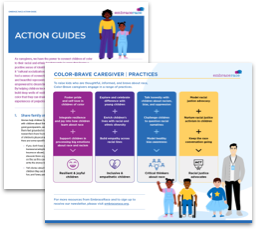3 Tips for Modeling Racial Justice Advocacy for Kids
Children learn from what they see their adults doing. Modeling advocacy for racial equity and for the well-being of all people - beyond your immediate family, friends, and social circle - is a powerful way to help children learn to care for and act in support of others.
Lend your voice, time, money, or whatever you can to causes and people who work to undo injustices experienced by historically oppressed groups. Take a racial equity lens to all causes in an effort to identify and change discriminatory organizations, institutions and systems.
Activity Ideas
-
Learn about and get involved in groups that work toward building solidarity and mutual support between and among communities of color.
-
Learn about groups like Black Lives Matter and similar racial justice groups, whether nationally or locally.
-
Learn about equitable alternatives to school funding policies.
-
Learn about reparations and Land Back initiatives.
-
Learn about public safety and crisis response programs that are designed to provide the services needed, while reducing harm to community members.
-
Learn about voting rights and initiatives that make it easier, not harder, for everyone to exercise their right to vote and for those votes to count equally.
-
When an issue surfaces or is presented, develop a habit of asking, “Where is race in this?”
Engaging in this practice will create opportunities to disrupt systems, institutions, and processes that are discriminatory and/or lead to inequitable outcomes.
Once you’ve learned about an organization, program, or policy you believe represents an effective intervention in an issue you care about, support it in any way you can. Change doesn’t happen simply because we care. Change happens because we take action to make our concerns and convictions manifest in the world. To read an article that articulates the urgency of the work and our need to act, please click here.
When you engage in activism and advocacy – big or small – recognize it as an opportunity to talk about values and principles with children.
Activity Ideas
-
If you attend marches, rallies, and vigils in support of racial justice, consider bringing your children along, or at least talk to them about the experience.
If you want to involve children in direct activism, here are some thoughts to consider. And check out this touching story of a mother bringing her children to honor Trayvon Martin’s memory and support his parents. Get arrested at a protest? You can talk about that, too.
-
Vote in every election you can, including local elections.
Bring kids with you, so they know what voting actually looks like. Talk to them about why you’re supporting particular candidates and why being an informed voter matters. You can even ask them ahead of time to help you research the platforms of different candidates!
-
When you support a cause by signing a petition, making a donation, or contacting a representative, talk to your children about it.
Explain why you support that initiative, and ask them why THEY think it’s important. Ground the conversation in concepts of living in alignment with your values, and helping make our society more fair.
-
Explore ways to get involved in your child’s school.
Consider joining the PTA/PTO and/or volunteering in the classroom if you’re able. Advocate for policies that promote equity in school discipline, dress codes, and educational opportunities. Find out how race-related history and current events are being taught and how the perspectives and contributions of people of color to many fields are being incorporated. If necessary, advocate for the use of resources from EmbraceRace, Teaching for Change, the Zinn Education Project, Learning for Justice, Facing History and Ourselves, and the Anti-Defamation League.
Change is a group effort and advocacy is far more effective when performed in collaboration with others. Children will benefit from seeing adults working together to fight for justice.
Activity Ideas
-
Make sure racial justice efforts center and are guided by the concerns of people of color.
-
Identify prominent activists and organizers in your local community.
Learn about them alongside children, and find out how you can support them.
-
Build coalitions to make change.
In the school context, this might mean organizing with other families, with other educators, or across families, educators, and administrators to push for equity. In the workplace, this might mean seeking out equity-minded colleagues to create plans for increasing the recruitment, hiring, and retention of people of color and promoting an inclusive climate where everyone feels a sense of belonging and that their voices are heard and experiences are valued.
-
Be thoughtful about the most impactful way to be a collaborator in a change effort.
Consider the change effort and your race when determining how to collaborate. For a specific change effort, ask yourself if it is most respectful and most helpful to be a leading voice or a supportive ally. By observing adults being both leader and ally, kids will learn to do things for others and for the greater good.
